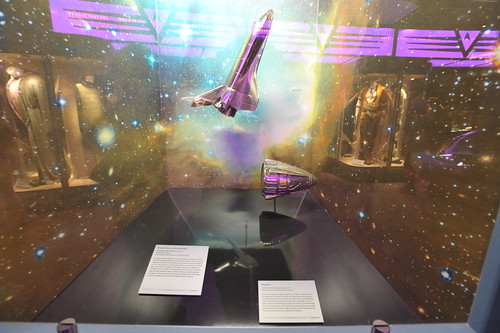
An indulgement, visiting the Star Trek Exhibition at Hollywood and Highland the other day to just see what it was all about. Turns out, it was mostly about a few ways to get visitors to say — oh, alright.. — when it came to liberating them from $20 here and $20 there for photos, lenticular gizmos and admission. But, I think it was worth it if only because I get a blog post out of it all.
One curiosity that made me chuckle, although not entirely unexpected, I was amused at how this one component of the exhibition — a long, multi-wall science-museum style “march of history” models-in-dioramas — made a tongue-in-cheek transition in historical timelines, from the *real* to the designed future history of Star Trek.
This one particular exhibit consists of a dozen or so Enterprises throughout history, starting with two US aircraft carriers, telling of their exploits in World War II in the Pacific; the Gulf War more recently, and so on. Okay, heard of them — a factoid or two. Then, onto the Space Shuttle Enterprise, named partially at the urging of ardent Star Trek fans. A gesture befitting the strength of the story to push the imagination toward space exploration. The materialization of an aspiration in the form of composite materials, redundant computer navigation systems, enormous engines and a phalanx of command-and-control tracking systems, pilot training programs, a number of firsts-into-space for various nationalities and professions, a spectacular disaster, the normalization of space travel, an X-prize, etc., etc.
Immediately next to the Space Shuttle Enterprise — is Zefram Cochane’s Phoenix — huh? The simple descriptive text, normalizing this future history’s first faster-than-light spacecraft, made me chuckle. Cheeky and clever little cognitive shift that made this part of the exhibit fun. The displays continue on, of course — to all the various Enterprises, with allusions to their demise, Captain’s, a touch and gesture toward a defining moment in their adventures/stories/shows (getting lost forever in the Delta Quadrant, equipped with wild Romulan technology, etc.)
Space Shuttle Enterprise
Prototype Reusable Orbital Spacecraft
NASA registry OV-101
Commanders: Fred W. Haise, Jr., Joseph H. Engle
The Space Shuttle Enterprise was the prototype vehicle for NASA’s fleet of reusable orbital spacecraft. Built in the mid-1970s by North American Rockwell, the Enterprise flew a series of critical test flights in 1977. The shuttle was released in mid-air by a Boeing 747 mother ship, after which it glided to landings at the desert lakebed at Edwards Air Force Base. The Enterprise paved the way for NASA’s space shuttle program, which carried numerous scientific payloads and space probes into orbit (including the Hubble Space Telescope), as well as a large portion of the International Space Station.
Phoenix
Experimental Warp-Powered Spacecraft
Designer, Builder, and Pilot: Zefram Cochrane
Earth’s first faster-than-light spacecraft was built in 2063 by Zefram Cochrane and Lily Sloane. Cochrane and Sloane built the Phoenix on an abandoned nuclear base, left over after Earth’s Third World War. Cochrane piloted the Phoenix’s historic first warp flight on April 5, 2063, a short jaunt, traveling just a few light minutes. During the flight, Phoenix’s warp signature was detected by a passing Vulcan survey ship, leading directly to Earth’s first official contact with extraterrestrial life. The ship now resides in the Smithsonian Insitution.
Why do I blog this? Just following and noting various simple strategies and literary devices to create moments of fiction within a blurrily factual world. In this case the future is assumed, and the past is reimagined to bring into alignment this future fictional world. Similar in many ways to Sascha’s The Golden Institute.
Did they note that the Borg briefly destroyed the Phoenix, disrupting First Contact, until after the Enterprise (that would be the Enterprise E, I believe) went back and managed to disrupt the destruction attempt?